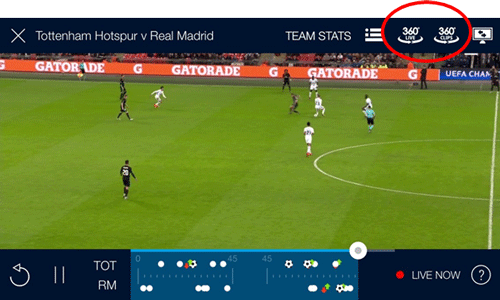Fundamentally, the shifting behaviour patterns of the consumer has influenced this adaptation of new technologies, such as e-sports, AR/VR and fantasy sports to name a selection. Grasping the attention of the consumer is as competitive as ever and now requires captivation methods for increased level of engagement.
For example, in 2017, consumers in the UK spent over £5.5bn on gaming equipment,. Whilst books, TV and radio provide some elements of interactivity between consumers, the digital mediated experience through the expansion of new technologies appears to be far richer than a human in-person experience (Miah, 2017). Linking to the advancements in the ‘Ecology of Cricket‘ piece in the blog, the enrichment of watching live sport through video replays has developed into a continued virtual personalisation of a live sporting event.
This has been developed through:
- AR/VR; full immersion in a sporting fixture through increased camera angles in the stadium (as shown in the image below), the ability to rewind to key moments brings an enrichment of being involved in the game whilst sat at home. One key prediction includes the potential to purchase a ticket to a live fixture and watch the full game via a VR headset, whilst sat at home.

- eSports; Many argue, the business of e-sports would take off if there was an injection of finance and an expansion of traditional sport’s managerial and marketing procedures (Newman et al., 2020). Also, the actual demographic ranges from 8 to 34 years old and encompasses 30% women and 70% men, who are passionate and socially engaged across various platforms. Reasons for involvement have shifted away from escapism towards playing competitions for prize money, with equipment adaptations in gaming keyboards, mouse’s and monitors. Large audiences have formed as (see image 2 below) due to the expertise of the athletes, as a result of long-term cultivation of and creativity resulting from their gaming craft (Brock and Johnson, 2021), the skill level now required is being directly compared to ‘real’ sporting athletes. Revenue is generated through traditional media streaming (e.g. Twitch) to more specific in game purchases, such as weapon upgrades in Call of Duty, linking to the convergence culture theory.
Image 2 – Viewing figures for large sporting events real and e-sports

- Fantasy Sports: Creating virtual values of athletes, such as in Fantasy Premier League, leads to ancillary consumption as researching data on athletes and teams generates transmedia consumption (as image 3 shows) leading to many leagues existing catering to different motivation levels. Fans now have pre-existing beliefs on players based on statistics in a virtual games, with the official Fantasy Premier League game now boasting more than eight million players.

Ultimately, the introduction of the metaverse will only increase the dominance of virtual sports as apposed to ‘real ones’, with fulfilling careers to be made in the digital world in comparison to athletic competition, a this allows a sense of identity with the gameThis is a fine balance as increased investment in future sports may hinder women’s sports however, with unfavourable comparisons made between male and female sports, e-sports are on a completely different trajectory.
Thanks for reading!
Check out my professional LinkedIn profile and Youtube below…
Enter your thoughts below…
